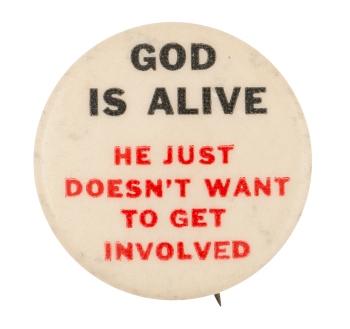| Category | |
|---|---|
| Additional Images | |
| Text on Button | GOD IS ALIVE HE JUST DOESN'T WANT TO GET INVOLVED |
| Image Description | Black and red text on a white background |
| Back Style | |
| The Shape | |
| The Size | |
| Additional Information | The message "God Is Alive—He Just Doesn’t Want To Get Involved!" was just one of many powerful and provocative messages that could be found scrawled across the walls of urban areas during the rise of graffiti art in the late 1960s. At this time, graffiti became a popular form of expression for young people who wanted to make a statement and be seen and heard. It was a way for them to rebel against the mainstream and show their creativity in a way that was not restricted by society's rules. Despite its popularity, graffiti was viewed by many as an act of delinquency and vandalism, rather than an art form. However, this perception began to shift in the 1980s when art galleries started to showcase graffiti as a legitimate form of artistic expression. This recognition of graffiti as art opened doors for many young artists who had previously been dismissed as vandals. One such artist was Jean-Michel Basquiat, who gained fame for his graffiti-inspired paintings and went on to become a significant figure in the art world. Basquiat's work was a reflection of the gritty, urban environment in which he lived, and his bold, colorful images captured the raw energy and emotion of the streets. Today, graffiti continues to be a powerful force in urban art and culture. While some still view it as a form of vandalism, others recognize it as a legitimate and important form of artistic expression. Whether it is viewed as an act of rebellion or a celebration of creativity, graffiti continues to captivate and inspire audiences around the world. |
| Sources |
“The History of American Graffiti:” From Subway Car to Gallery. (2011, March 31). PBS NewsHour. https://www.pbs.org/newshour/arts/the-history-of-american-graffiti-from…
|
| Catalog ID | HU0191 |


